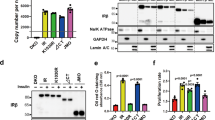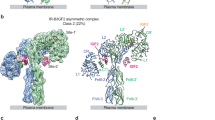Abstract
One of the two isoforms of the human insulin receptor (isoform A or IR-A) binds IGF-II with high affinity and is predominantly expressed in fetal tissues and malignant cells. We evaluated the biological relevance of IR-A in human myosarcoma cells. Six myosarcoma cell lines were studied. All produced high amounts of IGF-II and five of them predominantly expressed IR-A. SKUT-1 leiomyosarcoma cells, that do not express the IGF-IR, were identified as a suitable model to study the effects of IR-A in the absence of the interference of IGF-IR. In these cells, which express high levels of IR with an IR-A relative abundance of ≈95%, IGF-II elicits biological effects exclusively via IR-A activation and IGF-I is almost ineffective. Blockade of autocrine IGF-II reduced unstimulated cell viability and migration. Although both insulin and IGF-II activate IR-A, these two ligands showed a different ability to activate different intracellular signaling pathways and to elicit different biological effects. Insulin was more potent than IGF-II in activating the PI3-K/Akt pathway and in protecting cells from apoptosis. In contrast, IGF-II was more potent than insulin in activating the Shc/ERK pathway and in stimulating cell migration. These data indicate that IGF-II sensitive IR-A is the predominant IR isoform in a variety of myosarcoma cells. In SKUT-1 leiomyoma cells this fetal IR isoform may vicariate the IGF-IR for cell response to both insulin and IGF-II. Acting on the same IR-A receptor IGF-II is more potent than insulin in stimulating cancer cell migration.
This is a preview of subscription content, access via your institution
Access options
Subscribe to this journal
Receive 50 print issues and online access
$259.00 per year
only $5.18 per issue
Buy this article
- Purchase on Springer Link
- Instant access to full article PDF
Prices may be subject to local taxes which are calculated during checkout









Similar content being viewed by others
References
Bach LA, Hsieh S, Brown AL, Rechler MM . 1994 Endocrinology 135: 2168–2176
Baltensperger K, Lewis RE, Woon CW, Vissavajjhala P, Ross AH, Czech MP . 1992 Proc. Natl. Acad. Sci. USA 89: 7885–7889
Barber AJ, Nakamura M, Wolpert EB, Reiter CE, Seigel GM, Antonetti DA, Gardner TW . 2001 J. Biol. Chem. 276: 32814–32821
Bartucci M, Morelli C, Mauro L, Ando S, Surmacz E . 2001 Cancer Res. 61: 6747–6754
Belfiore A, Costantino A, Frasca F, Pandini G, Mineo R, Vigneri P, Maddux B, Goldfine ID, Vigneri R . 1996 Mol. Endocrinol. 10: 1318–1326
Cullen KJ, Allison A, Martire I, Ellis M, Singer C . 1992 Breast Cancer Res. Treat. 22: 21–29
Cullen KJ, Lippman ME . 1992 Cancer Treat. Res. 61: 413–431
Ebina Y, Ellis L, Jarnagin K, Edery M, Graf L, Clauser E, Ou JH, Masiarz F, Kan YW, Goldfine ID, Roth RA, Rutter WJ . 1985 Cell 40: 747–758
El-Badry OM, Minniti C, Kohn EC, Houghton PJ, Daughaday WH, Helman LJ . 1990 Cell Growth Differ. 1: 325–331
Forsayeth JR, Montemurro A, Maddux BA, DePirro R, Goldfine ID . 1987 J. Biol. Chem. 262: 4134–4140
Frasca F, Pandini G, Scalia P, Sciacca L, Mineo R, Costantino A, Goldfine ID, Belfiore A, Vigneri R . 1999 Mol. Cell Biol. 19: 3278–3288
Ganderton RH, Stanley KK, Field CE, Coghlan MP, Soos MA, Siddle K . 1992 Biochem J. 288: Pt 1 195–205
Heo DS, Park JG, Hata K, Day R, Herberman RB, Whiteside TL . 1990 Cancer Res. 50: 3681–3690
Hiromura K, Monkawa T, Petermann AT, Durvasula RV, Shankland SJ . 2002 Kidney Int. 61: 1312–1321
Imai Y, Clemmons DR . 1999 Endocrinology 140: 4228–4235
Kull Jr FC, Jacobs S, Su YF, Svoboda ME, Van Wyk JJ, Cuatrecasas P . 1983 J. Biol. Chem. 258: 6561–6566
Leibiger B, Leibiger IB, Moede T, Kemper S, Kulkarni RN, Kahn CR, de Vargas LM, Berggren PO . 2001 Mol. Cell 7: 559–570
Osborne CK, Coronado EB, Kitten LJ, Arteaga CI, Fuqua SA, Ramasharma K, Marshall M, Li CH . 1989 Mol. Endocrinol. 3: 1701–1709
Pandini G, Frasca F, Mineo R, Sciacca L, Vigneri R, Belfiore A . 2002 J. Biol. Chem. 277: 39684–39695
Peruzzi F, Prisco M, Dews M, Salomoni P, Grassilli E, Romano G, Calabretta B, Baserga R . 1999 Mol. Cell Biol. 19: 7203–7215
Roth RA, Cassell DJ, Wong KY, Maddux BA, Goldfine ID . 1982 Proc. Natl. Acad. Sci. USA 79: 7312–7316
Rubin R, Baserga R . 1995 Lab. Invest. 73: 311–331
Sciacca L, Costantino A, Pandini G, Mineo R, Frasca F, Scalia P, Sbraccia P, Goldine ID, Vigneri R, Belfiore A . 1999 Oncogene 18: 2471–2479
Sieg DJ, Ilic D, Jones KC, Damsky CH, Hunter T, Schlaepfer DD . 1998 EMBO J. 17: 5933–5947
Strauss G, Christensen L, Zapf J . 1994 J. Intern. Med. 236: 97–99
Ullrich A, Gray A, Tam AW, Yang-Feng T, Tsubokawa M, Collins C, Henzel W, Le Bon T, Kathuria S, Chen E, Jacobs S, Francke V, Ramachandran R, Fujita-Yamagughi Y . 1986 EMBO J. 5: 2503–2512
Vella V, Pandini G, Sciacca L, Mineo R, Vigneri R, Pezzino V, Belfiore A . 2002 J. Clin. Endocrinol. Metab. 87: 245–254
Vu TH, Yballe C, Boonyanit S, Hoffman AR . 1995 J. Clin. Endocrinol. Metab. 80: 1670–1676
Acknowledgements
We thank Dr A Colombatti, Aviano, Italy, and Dr P Russo, Catania, Italy, for kindly providing us with the sarcoma cells. This work was supported in part by grants from the Associazione Italiana per la Ricerca sul Cancro (AIRC), MURST (Cofin 2001 to A Belfiore) and MURST (cod. 202, 1998–2000 to R Vigneri).
Author information
Authors and Affiliations
Corresponding author
Rights and permissions
About this article
Cite this article
Sciacca, L., Mineo, R., Pandini, G. et al. In IGF-I receptor-deficient leiomyosarcoma cells autocrine IGF-II induces cell invasion and protection from apoptosis via the insulin receptor isoform A. Oncogene 21, 8240–8250 (2002). https://doi.org/10.1038/sj.onc.1206058
Received:
Revised:
Accepted:
Published:
Issue Date:
DOI: https://doi.org/10.1038/sj.onc.1206058
Keywords
This article is cited by
-
Identification of a novel EphB4 phosphodegron regulated by the autocrine IGFII/IRA axis in malignant mesothelioma
Oncogene (2019)
-
Identification of Insulin Receptor Splice Variant B in Neurons by in situ Detection in Human Brain Samples
Scientific Reports (2018)
-
Widespread alternative exon usage in clinically distinct subtypes of Invasive Ductal Carcinoma
Scientific Reports (2017)
-
Insulin-Like Growth Factor-II/Cation-Independent Mannose 6-Phosphate Receptor in Neurodegenerative Diseases
Molecular Neurobiology (2017)
-
Comparative transcriptomic analysis reveals the oncogenic fusion protein PAX3-FOXO1 globally alters mRNA and miRNA to enhance myoblast invasion
Oncogenesis (2016)



